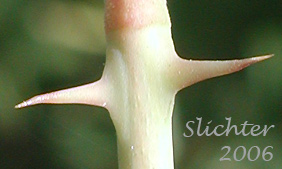Pearhip rose is a woody shrub with erect stems from 1-2 meters high. The stems bear strong, straight or slightly curved prickles below the stipules or bases of the petioles. The leaves are alternate on the stems and have 5-9 pinnately compound leaflets. The leaflets are ovate, obovate, or elliptic with toothed margins. Individual teeth may be greater than 1 mm in length and are only gland tipped in variety woodsii. The leaflets are up to 5 cm long and 2.5 cm wide.
The inflorescence is a small cluster or cyme of 3-5 flowers at the tips of the stems. The pinkish to rose-colored flowers are small and about 2.5-5 cm across with 5 petals. The petals are 1.5-2.5 cm long. The rose hips are globose, ellipsoid, or pear-shaped, and 6-12 mm long and wide. The hips are red and have sepals which persist at the tip of the fruit.
It may be identified from Rosa nutkana due to the smaller, clustered flowers.
1. Dried flower petals for scents, potpourri.
2. Rose hips are high in vitamin C, may be made into jam, tea, and used as flavoring.
3. The pearhip rose may be used as a hedgerow or as an ornamental.
4. The fruits are an important food source by various herbivores and upland game birds. The leaves and twigs are eaten by numerous browsers, and rose thickets provide excellent nesting and escape habitat for songbirds.
Pearhip Rose is found in moist open ground and open woods in the east Columbia River Gorge, and elsewhere in its range, prefers warm, dry sites, often mixed with Nootka rose..
Pearhip rose is found east of the Cascade summits in Washington and Oregon and south to southern California. It is found east to Minnesota, Wisconsin, Missouri and Texas.
In the Columbia River Gorge, it may be found between the elevations of 100'-2000' from near Bonneville Dam in the west to the east end of the Gorge.
